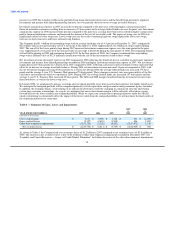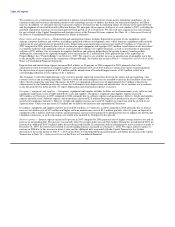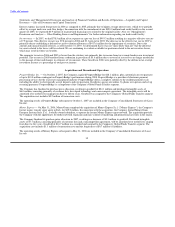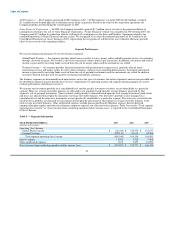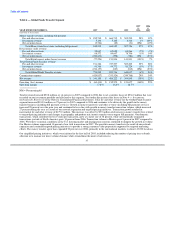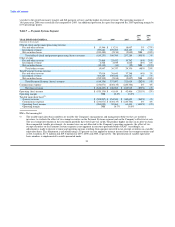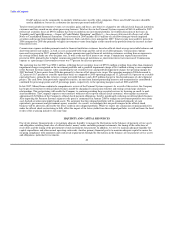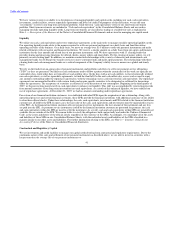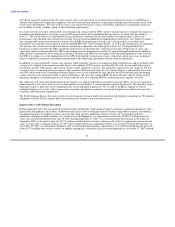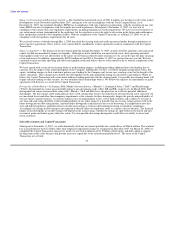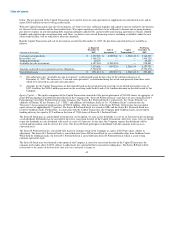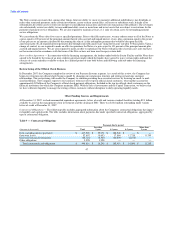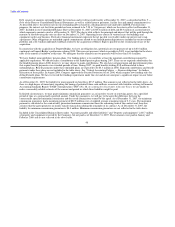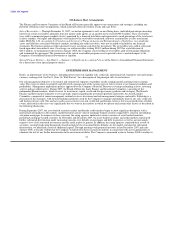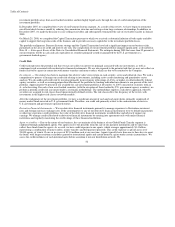MoneyGram 2007 Annual Report Download - page 45
Download and view the complete annual report
Please find page 45 of the 2007 MoneyGram annual report below. You can navigate through the pages in the report by either clicking on the pages listed below, or by using the keyword search tool below to find specific information within the annual report.
Table of Contents
provide for long-term capital needs. We strive to have cash, cash equivalents, receivables and investments in excess of our PSO in an
amount which allows us to maintain compliance with all contractual and regulatory requirements during normal fluctuations in the value
of our assets and liabilities. We refer to this excess as our unrestricted assets. Assets restricted for regulatory or contractual reasons are
not available to satisfy working capital or other financing requirements.
In connection with our senior credit facility, one clearing bank contract and the SPEs, we have certain financial covenants that require us
to maintain pre-defined ratios of certain assets to PSO as presented in the Consolidated Balance Sheets. As more fully described in
Note 9 — Debt of the Notes to Consolidated Financial Statements, the financial covenants under our credit facilities relate to the
maintenance of pre-defined ratios of interest coverage, leverage and consolidated total indebtedness (collectively, the "Debt Covenants").
One clearing bank contract has financial covenants that include the maintenance of total cash, cash equivalents, receivables and
investments in an amount at least equal to total outstanding PSO (the "Total Company Ratio"), as well as the maintenance of a minimum
103 percent ratio of total assets held at that bank to instruments estimated to clear through that bank (the "Clearing Bank Ratio").
Financial covenants related to the SPEs include the maintenance of specified ratios, typically greater than 100 percent, of cash, cash
equivalents and investments held in the SPE to outstanding payment instruments issued by the related financial institution. In addition,
under limited circumstances, these financial institution customers with SPEs have the right to either demand liquidation of the assets in
the SPEs or to replace us as the administrator of the SPE. Such limited circumstances consist of material, and in most cases continued,
failure to uphold our warranties and obligations pursuant to the underlying agreements with the financial institutions.
In addition, we are regulated by various state agencies which generally require us to maintain a pool of liquid assets and investments with
a rating of A or higher in an amount generally equal to the regulatory PSO measure, as defined by the state, for our regulated payment
instruments, namely teller checks, agent checks, money orders and money transfers. The regulatory requirements are similar to, but less
restrictive than, our unrestricted assets measure. The regulatory PSO measure varies by state, but in all cases is substantially lower than
our PSO as disclosed in the Consolidated Balance Sheets as we are not regulated by state agencies for PSO resulting from outstanding
cashier's checks or for amounts payable to agents and brokers. All states also require MPSI, the licensed entity and our wholly-owned
operating subsidiary, to maintain positive net worth, with one state also requiring MPSI to maintain positive tangible net worth.
The regulatory and contractual requirements do not require us to specify individual assets held to meet our PSOs, nor are we required to
deposit specific assets into a trust, escrow or other special account. Rather, we must maintain a pool of liquid assets. No third party places
limitations, legal or otherwise, on us regarding the use of our individual liquid assets. We are able to withdraw, deposit or sell our
individual liquid assets at will, with no prior notice or penalty, provided we maintain a total pool of liquid assets sufficient to meet the
regulatory and contractual requirements.
The Total Company Ratio is the most restrictive of our financial covenants under all contractual and regulatory requirements. We monitor
compliance with the Total Company Ratio by monitoring the amount of our unrestricted assets.
Impact of the Credit Market Disruption
During September 2007, the asset-backed securities market and broader credit markets began to experience significant disruption, with a
general lack of liquidity in the markets and deterioration in fair value of mortgage-backed securities triggered by concerns surrounding
sub-prime mortgages. In response to these concerns, the rating agencies undertook extensive reviews of asset-backed securities,
particularly mortgage-backed securities. As a result of these developments, we experienced a net decline of $230.5 million in the fair
value of its investment portfolio from June 30, 2007 through September 30, 2007. As we monitored the deterioration in the market in
September 2007, we decided to draw the $197.0 million available balance of our revolving credit facility to supplement our unrestricted
assets to ensure that a sufficient cushion over the Total Company Ratio was maintained if there was any further market deterioration. As
of October 30, 2007, we maintained compliance with all contractual and regulatory requirements, even without considering the proceeds
of the $197.0 million draw on the revolver. In addition, preliminary valuations of the investment portfolio as of October 31, 2007 showed
a
42


